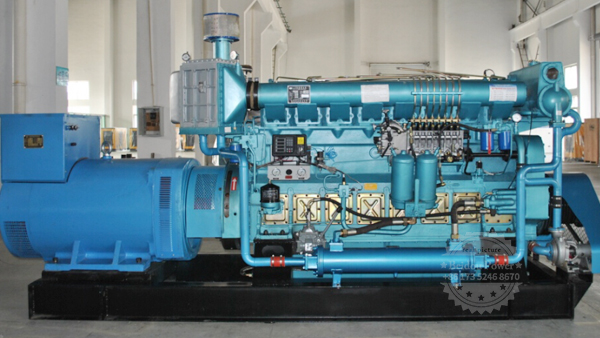The rotor winding of the generator is grounded at one point, which generally does not affect the normal operation of the generator. If another point of grounding occurs in the winding or excitation loop, forming a two-point grounding, the rotor winding, rotor core or reguard ring may be burned by the short-circuit DC current, and the magnetic circuit asymmetry formed by the partial short-circuit turns will cause the vibration of the unit to increase, and even cause the magnetization of the rotor body.
Possible reasons for rotor winding grounding are as follows:
a. Poor manufacturing and maintenance process. For example, the welding quality of the wire is poor, the groove lining is damaged, the lead wire from the rotor winding to the slip ring and the conductive screw insulation is damaged, and the welding slag and conductive dust are left behind.
b. Improper operation and maintenance. For example, the hydrogen humidity is high, the hydrogen contains oil, the insulation cylinder between the collector ring and the shaft, the collector ring and the lead connection accumulates toner, dirt, etc.
c. Design structural defects. For example, the main insulation of the old structure rotor is covered with protective steel armor, and the main insulation is damaged under heat expansion and mechanical action during operation, resulting in ground failure.
d. Poor material selection. The wire and insulation materials selected by the manufacturer are of poor quality and have congenital defects.
e. Improper storage of transportation.
During the process of transportation and storage, the insulation of the rotor is damp, dirty or the ventilation hole enters the foreign body.
Shaft voltage is a noteworthy problem in turbogenerator operation. Large turbine generator, if the shaft voltage suppression or protection measures are not proper, will lead to the motor shaft, bearing shell and turbine dynamic and dynamic parts of the magnetization and burn serious consequences.
Shaft voltage is mainly caused by the following four reasons:
(l) Shaft voltage caused by static charge of low pressure cylinder of steam turbine;
(2) Shaft voltage break caused by magnetic circuit asymmetry in generator manufacturing or operation
(3) the axial voltage caused by the pulsating component of the static excitation system;
(4) the unipolar potential generated by the short circuit between turns of the rotor winding.
The axial voltage caused by the above 1 to 4 items is mostly a few volts to tens of volts under normal conditions, and up to several hundred volts of AC voltage or DC (item l) voltage in serious cases.
Optional connection resistance or resistance and capacitance parameters, installed in the turbine or generator shaft end of the ground brush, and in the generator (exciter side) bearing base to install reliable insulation gaskets, can inhibit or prevent shaft voltage and shaft current caused by the harm.
The longitudinal magnetic flux formed by the short circuit between turns of the rotor winding in the rotating shaft not only passes through the journal, the bearing shell, but also through the blades, partitions and cylinder walls of the dynamic and static parts of the turbine, magnetizing these parts and generating unipolar potential.
Under normal circumstances, the unipolar potential generated by weak magnetization is only millivolt level, but when the rotor has a serious inter-turn short circuit or two-point grounding, the unipolar potential will reach several volts to ten volts, and the generator bearing oil film is broken down or the dynamic and static part of the turbine is contacted due to the expansion difference is too small, the unipolar current generated along the axial flow will reach hundreds of amps. It will not only burn the journal, bearing shell, dynamic and dynamic parts of the turbine, affect the correct operation of the turbine series shaft protection, but also aggravate the magnetization of these parts, which brings difficulties to the unit maintenance work. Therefore, it is necessary to demagnetize the large axis magnetization caused by accumulation of various reasons and the serious magnetization of the large axis after the generator accident. 3.2 Demagnetization method and evaluation of demagnetization effect There are two methods: DC demagnetization and AC demagnetization. Dc demagnetization method should be used for large components such as generator rotor, turbine rotor and cylinder wall. The basic principle of demagnetization is to rotate the demagnetized parts around the demagnetization coil, periodically change the direction of the current in the coil, and gradually reduce the size of the current, so that the magnetic field strength of the demagnetized parts is gradually reduced, and finally its remanence is small.
In order to effectively achieve the purpose of demagnetization, the number of ampere-turns of demagnetization should be selected as 4 to 5 times the remanence rating of the demagnetized part, and pay attention to the direction of the flux generated by the first demagnetization ampere-turns, should be opposite to the direction of remanence, and the demagnetization power supply can be used to reserve exciter or DC welding machine.
According to the experience of demagnetization of a number of 100-300MW large turbine generator sets, after the demagnetization of the parts, the journal and bearing shell are not more than 2×10-4T, other parts are not more than 10×10-4T, that is, even the pin can not absorb, that is, it is considered qualified.
For more questions about the generator set, please call the Beidou Power team. More than ten years of professional production and sales of power generation equipment experience, more professional engineer team to serve you, choose Beidou power is to choose rest assured, welcome on-site factory inspection.
Post time: Nov-22-2024

